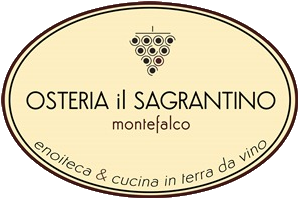In the heart of Umbria, also known as the green lungs of Italy, the medieval settlement of Montefalco sits on a hilltop 500 metres above sea level, dominating the Valle Umbra below. The municipality has 5,500 inhabitants distributed among its thirteen districts which spread out over the surrounding hills. And providing a splendid framework to this scene are the vineyards and olive groves that present a true portrait of the authentic Umbria. From the summit, there is a breathtaking view from Perugia to Spoleto, from Assisi to Trevi, and in the distance, the snow-capped (in winter), peaks of the Apennines. Since 1568, this stunning panoramic setting has been known as the “Balcony of Umbria”.
According to tradition, Montefalco was named by Federico II of Svevia. When the emperor visited the area in the XIII century he observed a great number of falcons and so decided to change the name from Coccorone, (Cors Coronae), to Montefalco. The presence of this mighty bird diminished over time and now it is merely an historic reference, although on July 31, 2007 a pair of kestrels was released over the town, with the aim of repopulating the skies with hunting birds. The project was a great success and the birds went on the reproduce in large numbers.
The City of Montefalco was conquered by Todi in the year 1280, and bearing witness to this event is the coat of arms of the victorious city, an eagle, which is attached to the wall of a palace to the right of the Gate of Sant’ Agostino. During this period of occupation by the people of Todi, the cultivation of the grape variety grechetto was added to the ancient tradition of red wine varieties and it was also a period of expansion and fortification: the public palace which today houses the municipal offices was built and many important religious structures were established. The city became the most important fortification in the Todi territories against Foligno and Spoleto until 1383 when it fell into the hands of the Trinci family of Foligno, and then, like many other Umbrian towns, it came under papal dominance.
What to see on a brief visit to Montefalco?
Let’s begin the tour around the splendid medieval walls with the entrance gates of Federico II, of Sant’Agostino, of Camiano della Rocca and of San Leonardo. Within these city walls are many churches, and one in particular is worth noting: Sant’Agostino was built together with a convent in the second half of the 13th century on a site with a pre-existing building which was thought to be consecrated to Saint John the Baptist.
Once inside the city walls, the first place to visit is the Church-Museum of Saint Francis which represents the synthesis of the history, culture and traditions of Montefalco. It was built between 1335 and 1338 by Franciscan monks and was the third Franciscan seat in the Montefalco area, but the first inside the city walls. In 1863 it was taken over by the Municipality and in 1895 it became home to the Civic Museum. Since 1990 the museum has been operating with three exhibition spaces: the deconsecrated Church with its world famous Benozzo Gozzoli frescoes depicting the life of Saint Francis, a nativity by the artist Perugino and frescoes from the 15th century Umbrian School of Artists; the art gallery, which houses many works by the artists Francesco Melanzio, Antoniazzo Romano, Niccolò Alunno, Melozzo da Forlì, paintings by the Umbrian School from the 14th to the 18th centuries and a collection of artisanal works; the crypt which contains archeological remains and a variety of sculptures and pieces from the various historical eras.
Leaving the museum, follow the street uphill and you find yourself in a magnificent circular piazza dominated by the Town Hall, the deconsecrated church of Saint Filippo Neri which today operates as a theatre, the Santa Maria concert hall and many fine examples of noble residences of the 16th century.
To complete your tour of Montefalco, we recommend that you also visit the Church of Santa Chiara della Croce. It was Saint Clare herself who ordered the construction of this church bearing her name and it is here that she was buried in 1308. The building was rebuilt twice, in 1430 and in 1615, and the severe, classic elegance of the facade represents the style of that period, while the interior exudes a solemn atmosphere with its three naves and a silver urn containing the preserved remains of Saint Clare. Diagonally across from the sacristy is the original Church of Santa Croce with its exquisite 14th century Umbria School frescoes.
From the time of Saint Clare there is also the Augustan monastery of Saint Clare, of which she became abbess in 1291. Visits to this closed monastery can be made on request, and it houses many works of art which were mostly installed in the 15th century cloister. One of the rooms contains a fresco by Benozzo Gozzoli in which Saint Clare is portrayed. The small cloister has a very special garden in which the flowerbeds represent the mystery of the Passion of Christ and it is here that the tree of Saint Clare grows. The berries of this tree are picked by the resident nuns and used to make rosary beads.
Montefalco plays host to three annual festivals:
- Gioco de La Ciuccetta: a traditional game open to everyone, that takes place under the loggia of the Town Hall on Easter Monday. It involves fresh eggs, either your own, or purchased at the event and requires that the participants challenge each other to breaking their eggs against the others: the winner is the person whose egg has the hardest shell and remains intact.
- La Fuga del Bove: The Race of the Bulls, which is a reenactment of a popular event held during the Christmas period in medieval times, but which is now held in August at the sporting arena. The players from each district of the town race each other along a preset course, while guiding a bull, (weighing between four to five hundred kilos). The final winner is awarded the Palio, an embroidered tapestry which every year is commissioned to a different artist and whose decorations are inspired by Montefalco itself and the characteristics of the event.
- La festa della vendemmia: This traditional Festival of the Grape Harvest is held annually on the third Sunday of September. Enthusiastic residents from all the outlying districts of the town join together in recreating age-old practices of the harvest period, from the picking through to the wine production and bringing back to life the farming traditions of years ago. Decorated carts are pulled through the streets of the town by equally colourful horses or tractors and are accompanied by locals in typical rustic dress. The parade finishes in the central piazza with lively eating, drinking, dancing and music.
- The month of August is dedicated to the event known as agosto montefalchese , and the town comes to life with taverns, bars and restaurants open till late, bringing thousands of tourists and locals alike to enjoy the festive atmosphere. The race Fuga del Bove brings the event to a close on the 19th of August.
Tourism in this area is not just about the beauty of the ancient villages, but also to a great extent about wine, the real emblem of the district thanks to the native Sagrantino. ( Read more in the dedicated section).
You absolutely mustn’t miss a visit to Montefalco, a true medieval jewel in the midst of vineyards and olive groves.






